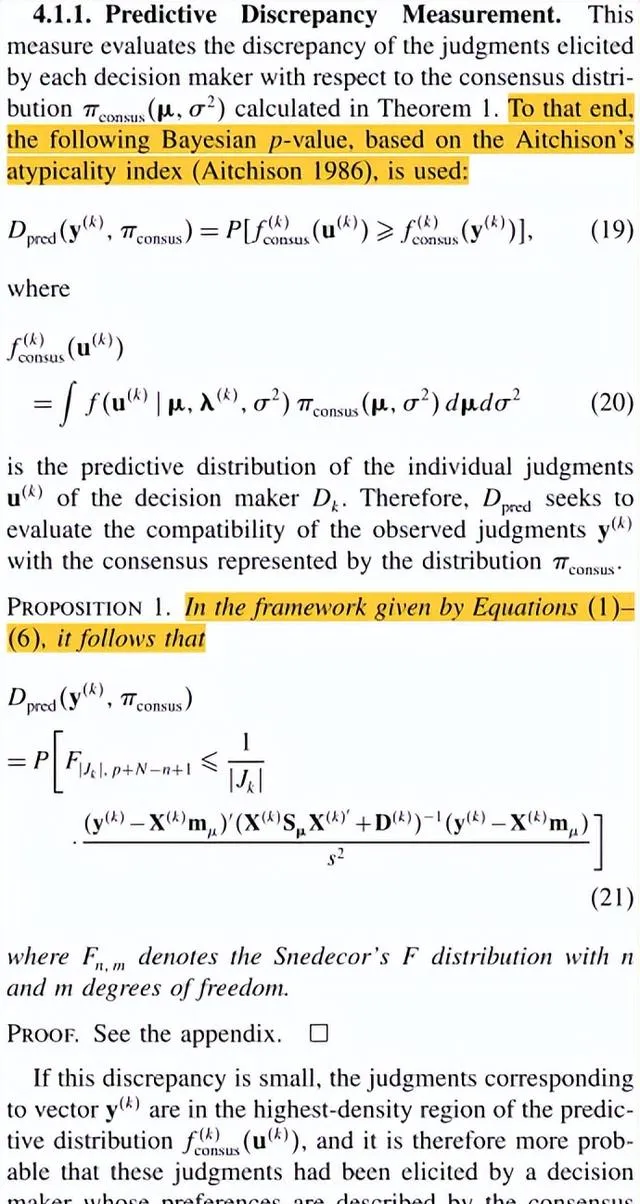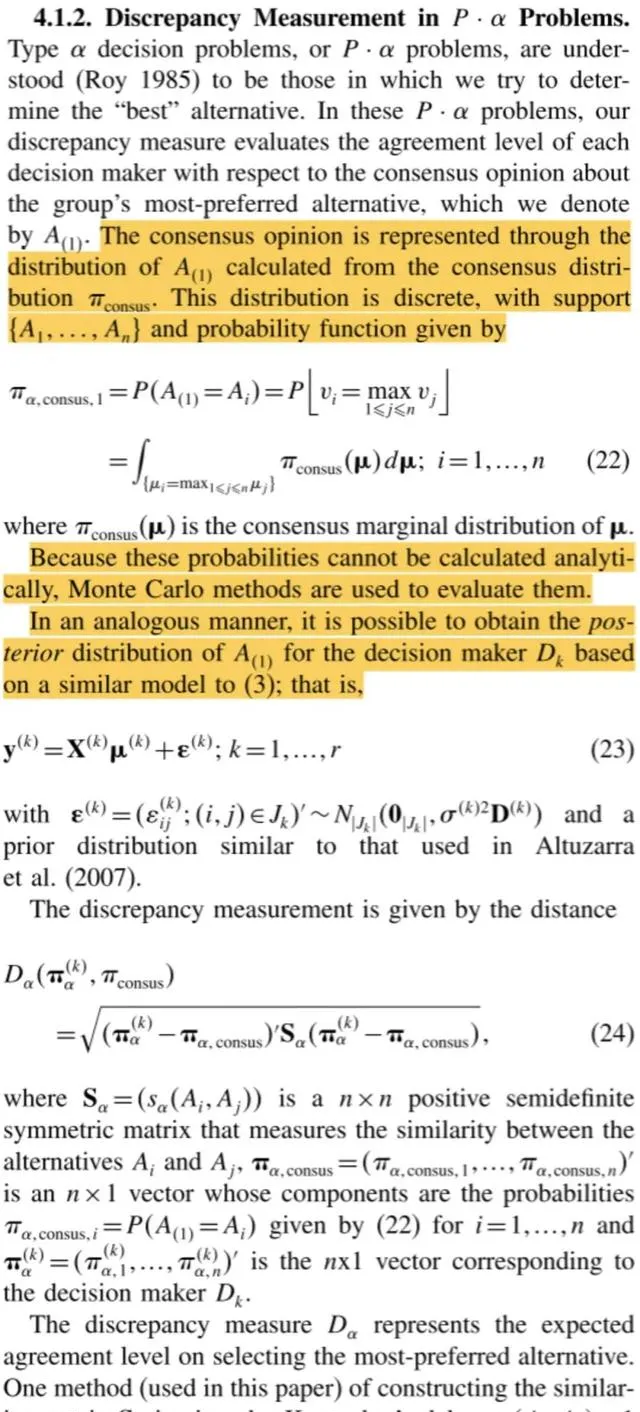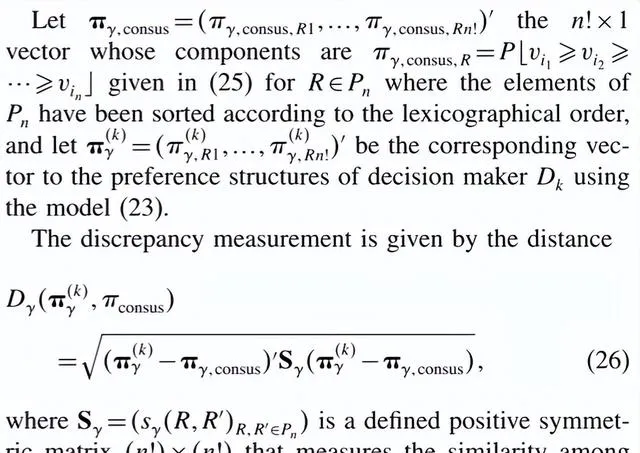
分享興趣,傳播快樂,
增長見聞,留下美好。
親愛的您,這裏是LearingYard學苑!
今天小編為您帶來精讀期刊論文【AHP群體決策中的一致性建立:貝葉斯方法】差異測量(1)。
歡迎您的存取!
Share interest, spread happiness,
increase knowledge, and leave beautiful.
Dear, this is the LearingYard Academy!
Today, the editor brings the "discrepancy Measurements (1) of the journal paper 'Consensus Building in AHP-Group Decision Making a Bayesian Approach' for abstract analysis".
Welcome to visit!
一、內容摘要(Summary of Content)
本期推文將從思維導圖、精讀內容、知識補充三個方面介紹精讀期刊論文【確定多內容群決策協調權的模型和方法】的差異測量(1)。
This tweet will present the discrepancy Measurements (1) of the intensively read journal paper "Consensus Building in AHP-Group Decision Making a Bayesian Approach" in terms of mind mapping, intensive reading content, and knowledge supplementation.
二、思維導圖(Mind Maps)

三、精讀內容(Intensive reading content)
在第四章節中,作者將介紹一個建立共識的半自動程式。這種半自動的方法是在任何互動過程中尋求共識的前一步。該方法辨識出不一致的行動者和判斷,並在修改行動者的態度以達成共識時建立不同的共識路徑。作者僅僅建立了一些共識路徑,幫助決策者在談判過程中固定他們的靈活性,但我們不能以封閉和確定性的方式確定最終的解決方案。
In Chapter 4, the author introduces a semi-automatic procedure for consensus-building. This semi-automatic approach is a step before seeking consensus in any interaction. The approach identifies inconsistent actors and judgments and establishes different consensus paths as the actor's attitudes are modified to reach consensus. The authors only establish some consensus paths to help decision makers fix their flexibility in the negotiation process, but we cannot determine the final solution in a closed and definitive way.
半自動程式由七個步驟組成,如下圖所示。分別為:步驟1,問題公式化;步驟2,共識分布的演算;步驟3,不一致性測量;步驟4,不一致的行為者和判斷;步驟5,結果分析;步驟6,尋求共識;步驟7,反饋階段。
The semi-automatic program consists of seven steps, as shown in the figure below. They are as follows: Step 1, problem formulation; Step 2: Calculation of consensus distribution; Step 3, inconsistency measurement; Step 4, inconsistent actors and judgments; Step 5, result analysis; Step 6, seek consensus; Step 7, feedback phase.

(一)預測離散測量(Predictive discrete measurement)
該度量評估每個決策者得出的判斷與定理1中計算的共識分布共識的差異,具體內容如下圖所示。
This measure assesses the difference between the judgment reached by each decision maker and the consensus distribution consensus calculated in Theorem 1, as shown in the figure below.

(二)P·α問題中的離散度量(Discrete metrics in P·α problems)
P·α問題被理解為是試圖確定「最佳」選擇的問題。在這些問題中,差異度量評估了每個決策者對群體最偏好的選擇的一致意見的一致程度,其具體內容如下。
The P·α problem is understood as one that attempts to determine the "best" choice. In these questions, the difference measure assesses the degree to which each decision maker agrees on the group's most preferred choice, as follows.

(三)P·γ問題中的離散度量(Discrete metrics in P·γ problems)
P·γ問題可以理解為試圖確定最優選的排序或選擇順序的問題。在問題中,差異度量旨在評估每個決策者對群體偏好結構的一致意見的一致程度。共識意見是透過偏好排名分布來表示的,該分布是從共識分布計算出來的。該分布是離散的,具體內容如下。
The P·γ problem can be understood as a problem that attempts to determine the most preferred sort or order of selection. In the problem, the difference measure aims to assess the extent to which each decision maker agrees on the structure of group preferences. Consensus opinion is represented by a preference ranking distribution, which is calculated from the consensus distribution. The distribution is discrete, as follows.

同樣地,這些概率無法透過分析計算,因此使用蒙特卡羅方法來評估它們。
Again, these probabilities cannot be calculated analytically, so the Monte Carlo method is used to evaluate them.

作者考慮到在P·α問題和P·γ問題問題中尋找差異度量,決定用與標積相關的歐幾裏得距離來表示它們,從而有利於使用多維標度(MDS)技術以圖形和清晰的方式呈現決策者分布與共識分布之間存在的差異。
Considering the search for difference measures in the P·α problem and the P·γ problem, the authors decided to represent them in terms of Euclidean distances associated with the scale product, thus facilitating the use of multidimensional scaling (MDS) techniques to graphically and clearly present the differences between the decision-maker distribution and the consensus distribution.
四、知識補充——差異量數(Knowledge supplement - measure of difference)
差異量數亦稱變異量數,又稱離散趨勢量數,它是統計學的基本概念之一,是表示樣本數據偏離中間數值的趨勢的量數,或者說它是反映樣本頻率分布離散程度的量數。
The measure of difference, also known as the measure of variance or the measure of discrete tendency, is one of the basic concepts of statistics. It is a measure that represents the tendency of sample data to deviate from the median value, or it is a measure that reflects the dispersion of the sample frequency distribution.
差異量數大,表示各數值分布的範圍廣且參差不齊;差異量數小,表示各數值較集中、整齊,波動的範圍振幅小。因此,集中量數的代表性如何,可由差異量數反映。差異量數愈大,則集中量數的代表性愈小;差異量數愈小,則集中量數的代表性愈大。所以,考察某種分布的差異量數,有助於對集中量數的理解。
The difference quantity is large, indicating that the distribution range of each value is wide and uneven; The difference quantity is small, indicating that the values are more concentrated and neat, and the fluctuation range is small. Therefore, the representativeness of the concentrated measure can be reflected by the differential measure. The larger the difference measure, the smaller the representative of the concentrated measure. The smaller the differential measure, the greater the representative of the concentrated measure. Therefore, the study of the differential measure of a certain distribution is helpful to the understanding of the concentrated measure.
常見的差異量數有平均差、變異數、標準差、全距、四分差、百分差等。
Common difference measures include mean difference, variance, standard deviation, range, quarter difference, percentage difference, etc.
今天的分享就到這裏了,
如果您對文章有獨特的想法,
歡迎給我們留言。
讓我們相約明天,
祝您今天過得開心快樂!
That's all for today's sharing.
If you have a unique idea about the article,
please leave us a message,
and let us meet tomorrow.
I wish you a nice day!
參考資料:谷歌轉譯、百度百科
參考文獻:
Alfredo Altuzarra, José María Moreno-Jiménez, Manuel Salvador. Consensus building in AHP-group decision making: a Bayesian approach [J]. Operations Research, 2010, 58(6): 1755–1773.
本文由LearningYard學苑整理並行出,如有侵權請在後台留言!
文案| Ann
排版| Ann
稽核| Zheng











